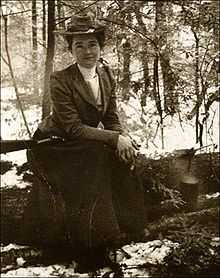Mina Benson Hubbard

Mina Benson Hubbard (April 15, 1870 - May 4 1956) was a Canadian explorer and was the first white woman to travel and explore the back-country of Labrador.[1] The Nascaupee and George River system were first accurately mapped by her in 1905.[2] She was the wife of Leonidas Hubbard who was famous for his ill-fated expedition to Labrador in 1903.
Early life
Mina Adelaine Benson was born on an apple farm near Bewdley in Ontario, Canada. Her father was James Benson, an Irish immigrant, and her mother was Jane Wood, from England. She was the seventh of eight children and received a primary education in the village school before teaching in Cobourg for two years.[3]
After graduating as a nurse in 1899, from the Brooklyn Training School for Nurses,[2] she went to work in a small hospital in Staten Island, New York. In 1900, she nursed the journalist Leonidas Hubbard whilst he was hospitalized with typhus. They married on 31 January 1901.
Expedition
Following her husband's ill-fated expedition, Hubbard asked a surviving member of the party, Dillon Wallace, to record the experience as a memorial to her husband. His published book, Lure of the Labrador Wild was a commercial success in America, but Hubbard was not satisfied, coming to believe that Wallace was responsible for the death of her husband, and that her husband's reputation had been blemished by Wallace's book.[4]
In 1905, whilst Wallace was planning to mount a new expedition to complete the goal of 1903, Hubbard put together a team of her own to do the same thing in a bid to clear her husband's name.[4] Consisting of the same George Elson who had been on the earlier expedition, along with two Cree Indians who had taken part in the unsuccessful rescue attempt in 1903, Hubbards team left Northwest River on June 27th,[2] the same day as the Wallace expedition.[2] The press branded it a race and it received considerable attention in the news. The two parties never communicated before or during the expedition.
The 576 mile trip was an efficient, well organised trek through the Labrador wilderness, completed on schedule,[4] despite weather delays at the beginning of August when they reached the watershed at Lake Michikamau.[2] The expedition arrived at the George River post on Ungava Bay on 29th August,[5] some seven weeks before Wallace.[6]
In 43 days of travelling, the Hubbard expedition confirmed that the Nascaupee, Seal Lake and Lake Michikamau were in the same drainage basin, and that the Northwest River and the Nascaupee were in fact the same. In addition, Hubbard made extensive notes on the topography, geology, flora and fauna of this unknown wilderness.[2] She named the source of the George River, Lake Hubbard after her husband.[7]
Her book, A Woman's Way Through Unknown Labrador, and her diaries provide descriptions of her encounters with the Naskapi and Montagnais Indians, and of the last great herds of Labrador's caribou.[4]
Later life
After the trip Hubbard carried out a lecture tour of England, where, in 1908, she met and married Harold Ellis, a British member of parliament. Together they had three children, but divorced in the 1920s.[4]
She returned to Canada in 1936 to accompany George Elson on a canoe trip down the Moose river in northern Ontario.[4]
Hubbard died in Coulston, United Kingdom, at the age of 86, when she was hit by a train while crossing railway tracks.[8]
Bibliography
- Woman's Way Through Unknown Labrador available at Internet Archive
See also
References
- ↑ Max Finkelstein, James Stone (2004) Paddling the Boreal Forest: Rediscovering A.P. Low page 16 Dundurn. ISBN 1770706682 Retrieved February 2015
- ↑ 2.0 2.1 2.2 2.3 2.4 2.5 Hodgins, B.W & Hobbs, M. (Ed.) (1987) Nastawgan: The Canadian North by Canoe and Snowshoe page125-128 Dundurn ISBN 096907834X Retrieved February 2015
- ↑ Bouchard, S. & Verdon, R (2009) [http: //www.radio-canada.ca/radio/profondeur/RemarquablesOublies/mhubbard.html Mina Hubbard: Remarkable forgotten] Retrieved December 2009
- ↑ 4.0 4.1 4.2 4.3 4.4 4.5 Richard Clarke Davis (Ed) (1996) Lobsticks and Stone Cairns: Human Landmarks in the Arctic page 292 University of Calgary Press ISBN 1895176883 Retrieved February 2015
- ↑ Richard Clarke Davis (Ed) (1996) Lobsticks and Stone Cairns: Human Landmarks in the Arctic page 286-288 University of Calgary Press ISBN 1895176883 Retrieved February 2015
- ↑ Wendy Roy (2005) Maps of Difference: Canada, Women, and Travel page 91 McGill-Queen's Press ISBN 0773528660 Retrieved February 2015
- ↑ Wendy Roy (2005) Maps of Difference: Canada, Women, and Travel page 94 McGill-Queen's Press ISBN 0773528660 Retrieved February 2015
- ↑ Buchanan, R. & Greene, B. (Ed) (2005) The Woman Who Mapped Labrador: The Life and Expedition Diary of Mina Hubbard page 432 McGill-Queen's Press ISBN 0773529241 Retrieved February 2015
Further reading
- Randall Silvis (2004) Heart so hungry: the extraordinary shipment of Mina Hubbard Into the Labrador wilderness Alfred A. Knopf ISBN 9780676975864
- Buchan, R. Hart, A. Greene, B. (2005) The woman Who Mapped Labrador McGill-Queen's University Press ISBN 9780773529243
- Davidson, J.W. & Rugge, J. (1998) Great Heart: The History of a Labrador Adventure McGill-Queen's University Press ISBN 9780670819508
- Alexandra Pratt (2002) Lost Lands, Forgotten Stories: A Woman's Journey to the Heart of Labrador Harper Perennial Canada ISBN 9780006485865
External links
- Biography - The Canadian Encyclopedia
- Works by Mina Benson Hubbard at Project Gutenberg
- Works by or about Mina Benson Hubbard at Internet Archive
- Audio Biography Radio Canada : Forgotten remarkable (French)
- "First Lady of Labrador" by Matthew Jachson